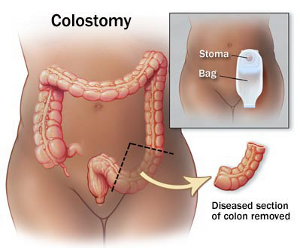Terms ostomy and stoma are general descriptive terms that are often used interchangeably though they have different meanings.
An ostomy refers to the surgically created opening in the body for the discharge of body wastes. A stoma is the actual end of the ureter or small or large bowel that can be seen protruding through the abdominal wall.
 The most common specific types of ostomies are described below:
The most common specific types of ostomies are described below:
- Colostomy - The surgically created opening of the colon (large intestine) which results in a stoma. A colostomy is created when a portion of the colon or the rectum is removed and the remaining colon is brought to the abdominal wall.
- Ileostomy - A surgically created opening in the small intestine, usually at the end of the ileum. The intestine is brought through the abdominal wall to form a stoma. Ileostomies may be temporary or permanent, and may involve removal of all or part of the entire colon.
- Urostomy - This is a general term for a surgical procedure which diverts urine away from a diseased or defective bladder. The ileal or cecal conduit procedures are the most common urostomies. Either a section at the end of the small bowel (ileum) or at the beginning of the large intestine (cecum) is surgically removed and relocated as a passageway for urine to pass from the kidneys to the outside of the body through a stoma. It may include removal of the diseased bladder.
